The Royal Edinburgh Military Tattoo is renowned the world over for its spectacle and precision. But this iconic show had surprisingly humble beginnings…
MORE FROM SCOTLAND MAGAZINE
Against the backdrop of Edinburgh’s historic castle, The Royal Edinburgh Military Tattoo is one of the most popular events in the city’s already impressive calendar. Celebrating the skills and talents of military bands and display teams from across the globe, over several weeks of performances — this year between 2 and 24 August — audiences enjoy massed pipes and drums, marching bands, dancers, and mock battles, all performed with clockwork military precision and showmanship.
With a yearly attendance now of over 200,000 and a 100,000,000 strong worldwide television audience, it is hard to believe that this enormous spectacle had such humble beginnings.
Let’s start with the name. The word ‘Tattoo’ comes from the Dutch phrase ‘doe den tap toe’ meaning ‘turn off the taps’ — a phrase used at closing time in 17th-century bars. The British Army stationed in Holland at the time adopted the practice of using this phrase and it became a signal, played by a regiment’s drum corps each night, that tavern owners should stop serving ales so that the soldiers would return to their barracks.
With the establishment of modern barracks and full military bands later in the 18th century, the term ‘tattoo’ was used to describe the last duty call of the day, and a ceremonial form of evening entertainment performed by military musicians.
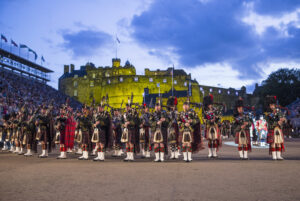
If you look up the definition of ‘Tattoo’ in the dictionary, you’ll see the meaning as ‘an evening drum or bugle signal recalling soldiers to their quarters.’ Now, the word ‘Tattoo’ is synonymous with military precision and spectacle the world over.
Edinburgh’s world-famous Tattoo first began over 70 years ago, in 1949, with a simple performance called Something About A Soldier at the Ross Bandstand in Princes Street Gardens. Lieutenant Colonel George Ian Malcolm, a past chief of Clan Malcolm, produced the show with the aim of bringing to life the Army’s contribution to the Edinburgh International Festival of Music and Drama, which runs in August every year.
The same year, the Lieutenant also produced a show entitled The King’s Men on the castle’s esplanade for a standing audience of 2,500. These two performances were so popular that the Lord Provost of Edinburgh, Sir Andrew Murray, invited the General Officer Commanding the Army in Scotland to present a military ‘show’ called the Edinburgh Tattoo.
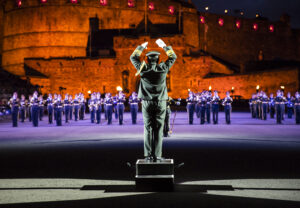
By the following year, this simple military performance now included eight items, and attracted an audience of 100,000 over its 20 performances. The grand castle setting was the backdrop for the inaugural production in 1950 and has remained its location ever since. As headquarters to one of Scotland’s most senior cavalry regiments, The Royal Scots Dragoon Guards, (who play a key role in the pipe and drum performances every year) and one of Scotland’s most recognisable landmarks, can you think of anywhere more monumental to host a show like this?
The year 1950 also marked the first royal attendance at the Tattoo, as Her Majesty Queen Elizabeth The Queen Mother, who was Queen Consort at the time, attended with her daughter HRH Princess Margaret. Since then, the show has been graced with several royal visits from senior members of the family and, in 2010, Queen Elizabeth II bestowed the Tattoo with the title ‘The Royal Edinburgh Military Tattoo’, to mark its 60th anniversary. HRH Princess Anne is Patron of the Tattoo and has attended on several occasions. Perhaps at this year’s show, which will pay tribute to the late Queen Elizabeth II, as well as celebrate the coronation of His Majesty King Charles III, we will see an appearance from our newly crowned King himself.
Since 1950, the show has continued to grow both in terms of production-size, audience, and participants. In 1952, the Pipes and Drums of the 1st Canadian Highland Battalion, La Fanfare à Cheval de La Garde Republicaine de Paris, and The Koninklijke Militaire Kapel (Royal Netherlands Grenadiers) became the first overseas performers at the Tattoo.
In the years since, the show has welcomed performers from across the globe, celebrating the skills and talents of military bands and display teams the world over.
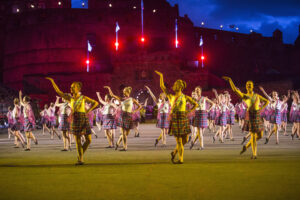
Norway, in particular, has been a regular performer at the Tattoo for over 30 years. In 1972, His Majesty the King’s Guard of Norway adopted one of Edinburgh Zoo’s penguins after their commander had been captivated by the colony on his previous visit in 1961. They named the penguin Nils Olav, after the Guard’s commander Major Nils Egelien and His Majesty King Olav. On adoption in 1972 the penguin held the rank of Lance Corporal, but each time the Norwegian Guard have visited Edinburgh the penguin has been promoted.
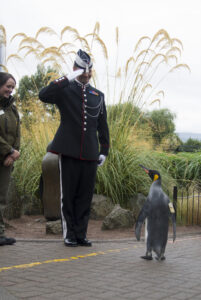
Although the original penguin passed away, he was replaced with Nils Olav II who was knighted in a ceremony personally approved by King Harald V himself. The newest penguin, Nils Olav III was last promoted in 2016, when he was bestowed the rank of brigadier. Now, 50 years on from the original adoption this unknowing penguin outranks the Guard’s Commander himself. We’ll have to wait and see whether another honour will be bestowed upon him this year during the Norwegian Guard’s visit to the city.
Penguins aside, the Tattoo’s reputation for excellence and spectacle is renowned the world over, aided by the fact that a large portion of the profits from the show are donated to charities including the RAF Benevolent Fund and the Soldiers’ Charity, providing lifetime support to soldiers, veterans, and their families through difficult times.
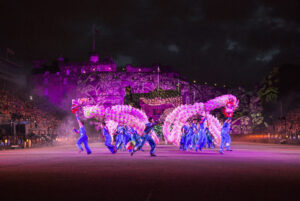
The theme of 2023’s Tattoo is Journeys and will see over 800 UK and international performers celebrate nautical themes whilst taking audiences on a musical journey around the globe. In addition to the renowned musicianship of His Majesty’s Royal Marines Bands, this year’s show will feature performances from Switzerland, the United Kingdom, India, Australia, Canada and the United States of America.
With the sound of drums, marching feet and massed pipes echoing through Edinburgh’s historic streets, we can’t think of anywhere we’d rather be this summer.
This year’s Tattoo will run from 2-24 August. Tickets are available at edintattoo.co.uk
Read more:
MORE FROM SCOTLAND MAGAZINE

SCOTLAND MAGAZINE
Published six times a year, every issue of Scotland showcases its stunning landscapes and natural beauty, and delves deep into Scottish history. From mysterious clans and famous Scots (both past and present), to the hidden histories of the country’s greatest castles and houses, Scotland‘s pages brim with the soul and secrets of the country.
Scotland magazine captures the spirit of this wild and wonderful nation, explores its history and heritage and recommends great places to visit, so you feel at home here, wherever you are in the world.